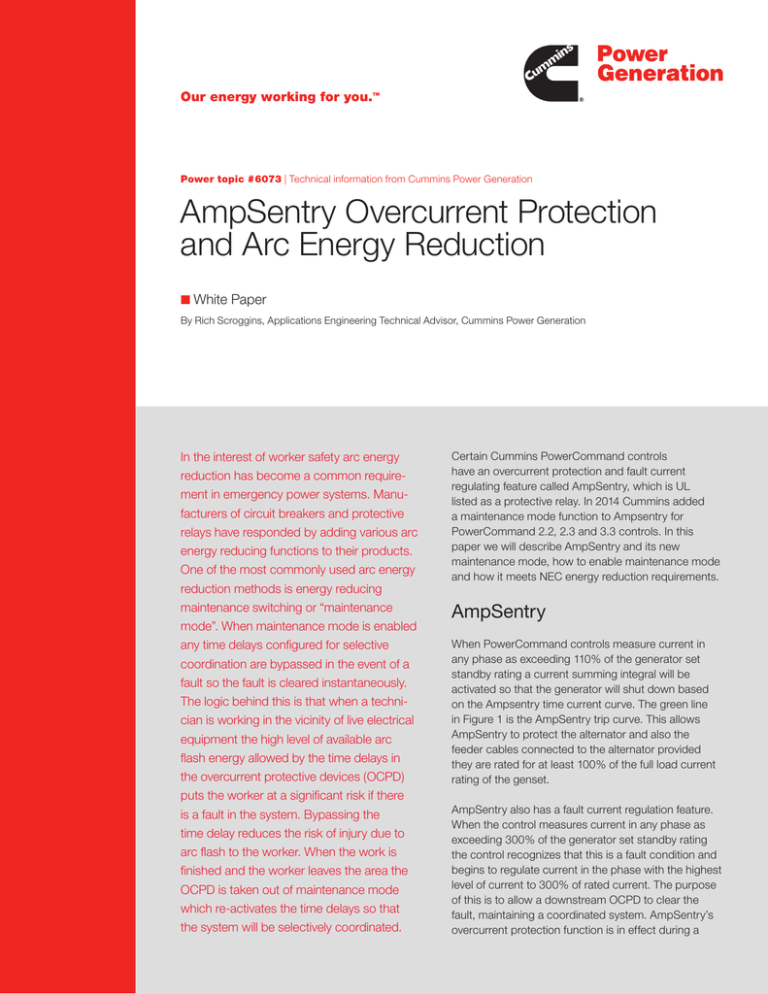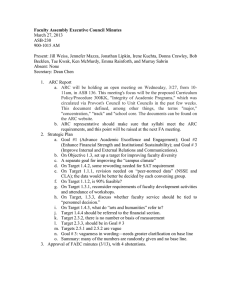
Our energy working for you.
TM
Power topic #6073 | Technical information from Cummins Power Generation
AmpSentry Overcurrent Protection
and Arc Energy Reduction
■ White Paper
By Rich Scroggins, Applications Engineering Technical Advisor, Cummins Power Generation
In the interest of worker safety arc energy
reduction has become a common requirement in emergency power systems. Manufacturers of circuit breakers and protective
relays have responded by adding various arc
energy reducing functions to their products.
One of the most commonly used arc energy
reduction methods is energy reducing
maintenance switching or “maintenance
mode”. When maintenance mode is enabled
any time delays configured for selective
coordination are bypassed in the event of a
fault so the fault is cleared instantaneously.
The logic behind this is that when a technician is working in the vicinity of live electrical
equipment the high level of available arc
flash energy allowed by the time delays in
the overcurrent protective devices (OCPD)
puts the worker at a significant risk if there
is a fault in the system. Bypassing the
time delay reduces the risk of injury due to
arc flash to the worker. When the work is
finished and the worker leaves the area the
OCPD is taken out of maintenance mode
which re-activates the time delays so that
the system will be selectively coordinated.
Certain Cummins PowerCommand controls
have an overcurrent protection and fault current
regulating feature called AmpSentry, which is UL
listed as a protective relay. In 2014 Cummins added
a maintenance mode function to Ampsentry for
PowerCommand 2.2, 2.3 and 3.3 controls. In this
paper we will describe AmpSentry and its new
maintenance mode, how to enable maintenance mode
and how it meets NEC energy reduction requirements.
AmpSentry
When PowerCommand controls measure current in
any phase as exceeding 110% of the generator set
standby rating a current summing integral will be
activated so that the generator will shut down based
on the Ampsentry time current curve. The green line
in Figure 1 is the AmpSentry trip curve. This allows
AmpSentry to protect the alternator and also the
feeder cables connected to the alternator provided
they are rated for at least 100% of the full load current
rating of the genset.
AmpSentry also has a fault current regulation feature.
When the control measures current in any phase as
exceeding 300% of the generator set standby rating
the control recognizes that this is a fault condition and
begins to regulate current in the phase with the highest
level of current to 300% of rated current. The purpose
of this is to allow a downstream OCPD to clear the
fault, maintaining a coordinated system. AmpSentry’s
overcurrent protection function is in effect during a
fault and will shut down the generator set based on the
time current curve if the fault is still active. Note that
in Figure 1 as fault current decays to 300% of rated
current AmpSentry holds the current constant at that
level until the line crosses the AmpSentry trip curve.
AmpSentry Maintenance Mode
PowerCommand AmpSentry’s Maintenance Mode
function acts in the same manner as maintenance
mode on a circuit breaker. When maintenance mode
is enabled AmpSentry shuts down the generator
set (by shutting off fuel and excitation) as soon as it
recognizes that current on any phase has exceeded
300% of the generator set rating. The short circuit
shutdown event can also be mapped to one of the
customer configurable outputs of the control to shunt
trip a breaker providing immediate isolation. Tests have
shown that excitation is shut off within 50 msec of
the occurrence of the fault. In Figure 1, the red line is
activated as the trip curve when maintenance mode is
enabled. Note that for current less than 300% of rated
current the maintenance mode trip curve is the same
as the standard AmpSentry trip curve.
Figure 2 displays a current trace created during a test
of AmpSentry Maintenance Mode. Note that in this
test the control recognized the fault within 38 msec
of the fault occurrence and shut off the genset fuel
and excitation. The current decayed exponentially
according to the transient time constant.
Figure 2. Control response and fault current decay resulting from a
short circuit with AmpSentry Maintenance Mode active
Enabling AmpSentry
Maintenance Mode
Maintenance Mode is enabled by either activating a
configurable customer input while the control switch is
in “Auto” or by plugging in the InPower Service tool.
There are several customer configurable inputs on the
PowerCommand controls that can be configured as
the Maintenance Mode enable switch by connecting
a pair of dry contacts between two terminals on
the control terminal block. InPower can be used to
configure the input as the maintenance mode enable
switch. The input can be configured to be either active
closed or active open. Figure 3 displays an example of
setting up a configurable input in InPower.
Fault code 5399 becomes active whenever Ampsentry
maintenance mode is enabled. As a default this fault
code is set up as an event only. By configuring this
fault code to be a warning the control can log when
maintenance mode is enabled and disabled. This log
may be useful if the genset ever does sustain a short
circuit. Figure 4 shows an example of how to use
InPower to set up control to log the maintenance
mode event.
02 | Power Topic #6073
Figure 1. AmpSentry Time Over Current curve. Includes symmetric
and asymmetric fault current decrement curves for a DQLD 2750 kW
genset.
Figure 3. Setting up a configurable input to enable maintenance mode
Figure 4. Ampsentry maintenance mode fault code
The 2014 version of the NEC requires that OCPD’s
rated 1200 amps and higher have some type of arc
energy reduction function. Relevant text from the 2014
NEC is printed below:
240.87 Arc Energy Reduction
Where the highest continuous current trip setting
for which the actual overcurrent device installed in a
circuit breaker is rated or can be adjusted is 1200 A
or higher, 240.87 (A) and (B) shall apply.
(A) Documentation. Documentation shall be
available to those authorized to design, install,
operate, or inspect the installation as to the location
of the circuit breaker(s).
(B) Method to Reduce Clearing Time. One of the
following or approved equivalent means shall be
provided:
1. Zone-selective interlocking
2. Differential relaying
3. Energy-reducing maintenance switching
with local status indicator
4. Energy-reducing active arc flash mitigation system
5. An approved equivalent means
Informational Note No. 1: An energy-reducing
maintenance switch allows a worker to set a circuit
breaker trip unit to “no intentional delay” to reduce
the clearing time while the worker is working within
an arc-flash boundary as defined in NFPA 70E-2012,
Standard for Electrical Safety in the Workplace, and
then to set the trip unit back to a normal setting after
the potentially hazardous work is complete.
03 | Power Topic #6073
NEC Arc Energy Reduction
requirements
AmpSentry clearly meets the requirement for arc
energy reduction as defined in NEC 240.87. The fact
that the text in the informational note refers to a circuit
breaker does not mean that only a circuit breaker
can be used to meet this requirement. The fact that
the code allows for “an approved equivalent means”
underscores the point that a circuit breaker is not the
only means for meeting this requirement.
Arc Energy Calculation
NFPA 70E references the IEEE 1584 method for
estimating Arc Flash energy. This method is also used
by SKM Power Tools software as well as other power
system analysis programs. In addition to available fault
current and arc interrupting time arc energy depends
on a number of site specific factors such as system
voltage, grounding method, conductor gap and
working distance. Because of this arc energy available
from a genset is site specific and within a site the arc
flash incident energy will vary throughout the electrical
distribution system based on cable resistance between
the sources and the fault and on other sources such
as motors that could feed the fault.
To illustrate the arc energy reduction capabilities of
maintenance mode we have done calculations of arc
energy for a specific generator set, a 2750 kW,
480 volt DQLD model. Note that these calculation
are for comparison purposes only. In Table 1 we have
calculated theoretical arc flash energy at the output
of the generator using the IEEE 1584 method and
parameters for a 480 volt, solidly grounded system
for arcs in a box in low voltage panel board class of
equipment. This calculation is intended for illustrative
purposes only. Actual arc flash calculations should be
performed by a licensed Professional Engineer taking
into account all of the characteristics of the site.
Arc Flash Incident Energy — cal/cm^2
AmpSentry — current reduced to 300% of
rated for 2 seconds
58.1
AmpSentry — maintenance mode —
immediate shutdown
11.3
AmpSentry maintenance mode —
breaker trip
3.57
Table 1. Arc Flash Energy Calculations – IEEE 1584 Method
Arc flash energy is calculated for three scenarios:
One without maintenance mode enabled, one with
maintenance mode enabled and one with maintenance
mode enabled with a configurable output wired to
shunt trip a breaker.
For a DQLD 2750 kW Genset without maintenance
mode active we calculated an arc flash energy level
of 58.1 cal/cm2. In this scenario arcing current is not
interrupted but the arc duration is 2 seconds. NFPA
70E (D.7.3) recognizes 2 seconds as a reasonable
maximum time for calculations because a person
will likely move away from the arc quickly if physically
possible. In this scenario arc flash energy is calculated
for both the transient period and the steady state
period. This is how SKM calculates arc energy from a
generator set in recognition that fault current from a
synchronous generator decays rapidly. Three phase
bolted fault current is used in the transient period
calculation. 300% of rated current is used in the steady
state calculation to correspond with AmpSentry’s fault
current regulation function.
With AmpSentry Maintenance Mode enabled we
calculated an arc flash energy level of 11.3 cal/cm2.
With Maintenance Mode enabled the control shuts off
fuel and excitation immediately on recognizing the fault.
The arc doesn’t necessarily immediately extinguish
however due to energy stored in the windings. As can
be seen in Figure 2 when excitation is shut off fault
current decays exponentially based on the transient
time constant. It takes 1 transient time constant (0.19
sec for this alternator) for the current to decay to a level
that the arc extinguishes. (NFPA 70E D.5(1) states that
the industry accepted minimum level for a sustaining
arcing fault is 38 percent of available bolted fault
current. 38 percent of initial current corresponds to
1 time constant.)
04 | Power Topic #6073
AmpSentry Maintenance Mode provides “energy
reducing maintenance switching” as enumerated in
240.87(B)(3). The informational note describes the
energy reducing maintenance switch as allowing a
worker to set a breaker trip unit to “no intentional
delay” while working within the arc flash boundary and
then to set the trip unit back to a normal setting after
the work is complete.
About the author
We calculated an arc flash energy level of 3.57 cal/cm2
for the scenario in which a configurable output of the
control is wired to shunt trip a breaker at the instant
that the control recognizes the fault, isolating the
working space from the energy stored in the alternator
windings. Tests have shown that AmpSentry will
recognize the fault within 50 msec. For this calculation
we used 60 msec for the duration of the arc, allowing
10 msec for the breaker to clear.
and remote monitoring products and has developed
and conducted seminars and sales and service training
internationally on several products. Rich received his
bachelors degree in electrical engineering from the
University of Minnesota and an MBA from the University
of St. Thomas.
Conclusion
Arc energy reduction requirements have been added
to the National Electrical Code as a means for
improving worker safety. Cummins Power Generation’s
AmpSentry protective relay with Maintenance Mode
has the functionality to meet all of an onsite emergency
generator’s NEC requirements for overcurrent
protection and arc energy reduction.
power.cummins.com
©2015 Cummins Power Generation Inc.
All rights reserved. Cummins Power Generation
and Cummins are registered trademarks of
Cummins Inc. “Our energy working for you.”
is a trademark of Cummins Power Generation.
NAPT-6073-EN (05/15)
05 | Power Topic #6073
Rich Scroggins is a Technical Advisor in the
Application Engineering group at Cummins
Power Generation. Rich has been with Cummins
for 18 years in a variety of engineering and
product management roles. Rich has led product
development and application work with transfer
switches, switchgear controls and networking



